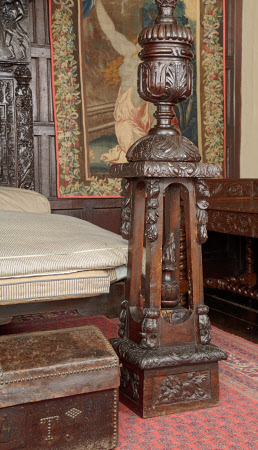Tester bed
Date
circa 1850 (with earlier elements)
Materials
Oak, Textile
Measurements
223 cm (H); 77 cm (W); 226 cm (D)
Place of origin
England
Order this imageCollection
Speke Hall, Merseyside
NT 1196586
Caption
One of several four-poster beds at Speke Hall is known as St Raymund’s, from the Continental carved portrait of a medieval monk which has been reused in the headboard. Other parts of the bed are of English origin – the open-work footposts being Victorian and possibly created by a Liverpool workshop.
Summary
An oak tester bedstead, probably English, constructed circa 1850 incorporating earlier European carved elements. The tester carved with cherub heads, angels and a lamb with a pierced scroll frieze. The headboard with arcaded panels and a medallion of St. Raymund flanked by panels of St Nicholas of Bari, possibly Bishop of Myraand and possibly St. Margaret of Antioch. The tester held at the foot end on turned cup and cover columns joining pierced square pedestals centred with flaming torches.
Provenance
Speke Hall and its contents were bequeathed, as a secondary devise, to the National Trust by Adelaide Watt (d.1921) in 1943. Speke was initially bequeathed to the Norris family (who built the original house during the 16th century). It was then leased to Liverpool City Council and later to the Museums Department of Merseyside County Council. The National Trust took over direct management of the house and its contents in 1986.



